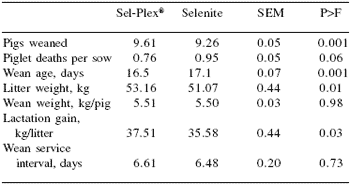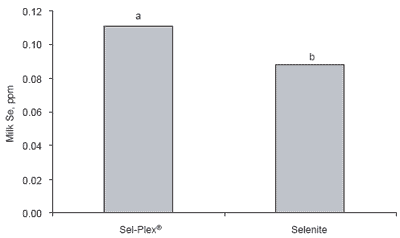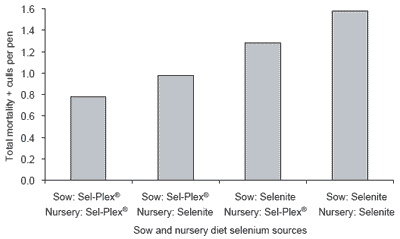Piglet survivability and performance: Sel-Plex® versus sodium selenite in sow and nursery diets
Antioxidant functions have been implicated, since several of the selenoproteins have known or suspected antioxidant roles, the most familiar being glutathione peroxidase (GSH-Px), which neutralizes hydrogen peroxide.
More extensively understood is the impact of sow selenium status on that of her progeny. Piglets born to sows supplemented with organic selenium in the form of Sel-Plex® selenium yeast had higher tissue selenium content at birth and at weaning than piglets from sows given an equal amount of inorganic (selenite) selenium (Mahan and Kim, 1996; Mahan and Peters, 2004).
Sow milk selenium content was also higher in Sel-Plex®- supplemented sows, indicating better ability of the sow to supply piglet selenium needs through to weaning (Mahan and Kim, 1996; Mahan, 2000; Mahan and Peters, 2004).
Inorganic selenium in the form of sodium selenite is routinely added to pig diets at 0.03 ppm Se, however its addition has not eliminated selenium deficiency.
Selenium yeast has only been approved by the FDA for use in swine feeds since 2002 following review of the data submitted on Sel-Plex® in support of the food additive petition. The purpose of this trial was to evaluate replacement of inorganic selenium (selenite) with Sel- Plex® in a large scale commercial swine system in terms of its impact on litter and nursery pig performance.
Sow reproduction parameters, pre-weaning survivability and performance of piglets after weaning were evaluated.
Sel-Plex® vs selenite selenium in sow diets: effects on reproductive performance
METHODS
This trial was conducted in a commercial 3400 head sow facility in south central Iowa. The herd was PRRS positive/stable, Myco-positive and SIV positive. A total of 756 sows (Cambrough 42 females bred to line 280 PIC boars) were utilized in a study that encompassed six weeks of production. Sows were blocked by parity (Table 1) in a completely randomized design. Average parity in both treatment groups was 3.74. Treatments consisted of 0.3 ppm Se in the complete diet added from either: 1) Sel-Plex® or 2) sodium selenite.
Table 1.Parity distribution of sows by treatment.

Sows began receiving experimental diets at 72 to 79 days of gestation. Sows received 2.5 kg of feed daily per sow until transfer to the farrowing house, at which time they were placed on respective lactation treatment diets and fed ad libitum until weaning.
Gestation and lactation diets contained 12.5 and 18.3% CP, 0.6 and 1.1% lysine, and 3236 and 3463 kcal/kg ME, respectively. Piglet numbers were equalized among litters on day of birth, with cross-fostering maintained within treatment. Weaning of all litters took place at >12 days of age.
Numbers of piglets born alive, stillborn and mummified, birth weight, piglet deaths per sow during lactation, numbers weaned and litter weaning weight were recorded. Milk samples from three sows (parity >4) per treatment, by actual week of farrowing, were collected on approximately day 10 of lactation and analyzed for milk selenium content.
All data were subjected to ANOVA. Sows were considered experimental units.
RESULTS
No treatment x parity interactions were observed (P > 0.19), therefore data are presented as main effects (LS means).
Numbers of piglets born alive and stillbirths were similar between treatments (Table 2). There were fewer mummified piglets born to sows receiving sodium selenite (P<0.10). Individual piglet birth weight was greater (P<0.10) when sows received inorganic selenium, however total litter birth weight was unaffected.
Table 2.Effects of sow selenium source on litter parameters.

There were fewer piglet deaths per sow in Sel-Plex®- supplemented sows than in those receiving selenite Se (P<0.10); and the number of piglets weaned was greater (P<0.001) when sows were fed Sel-Plex® (Table 3).
Expressed as a percentage ([1–(total pigs weaned/total pigs born alive)]*100), pre-weaning mortality in sows given Sel-Plex® was 9.76 vs 11.30% for sows receiving sodium selenite.
Table 3.Effect of sow diet selenium source on litter performance and wean-to-service interval.

Litter weights at weaning and total litter gain during lactation were higher when sows were given Sel-Plex® (P<0.01 and P<0.05, respectively). Average age at weaning was less (P<0.001) for Sel-Plex® sows (16.5 days vs 17.1 days), however wean-to-service interval was unaffected.
Thus, even though the Sel-Plex®- supplemented sows weaned a larger and younger litter, there was no adverse effect on wean-to-service interval.
Supplementation with Sel-Plex® during lactation increased milk selenium content by 26% (0.111 vs 0.088 ppm, P<0.01) (Figure 1).

Figure 1.Effect of sow dietary selenium source on milk selenium content at day 10 of lactation (abP<0.01, SEM = 0.003).
Effects of selenium source in sow and nursery diets on piglet performance after weaning
METHODS
Piglets (1000) weaned on two days (7 days apart) were assigned to treatments in 2 x 2 factorial treatment structure testing effects of sow diet selenium source and nursery diet selenium source (Sel-Plex® vs sodium selenite). Equal numbers of piglets were weaned from each sow treatment on each wean date.
Pigs were penned in groups of 25 (0.25 m2/ pig). There were 10 pens per treatment and treatments were randomly located within the nursery. Pigs were fed a 3- phase nutrition program during the 42-day nursery trial (7, 7 and 28 days for Phase 1, 2 and 3 diets, respectively.)
All diets contained 0.3 ppm Se from either Sel-Plex® or selenite. Pigs were weighed by pen and feed disappearance was calculated at days 7, 14, 21, 28 and 42 of the trial. Mortality, morbidity, daily gain, feed conversion and end weight data were collected and subjected to ANOVA. Pen was the experimental unit.
Model statement: variable = sow selenium source, nursery selenium source and barn fill date. Sow selenium source x nursery selenium source x barn fill date served as the error term.
Blood samples were collected for serum selenium determination from five pigs from four randomly chosen pens per treatment at the initiation of the nursery trial. At day 0, serum selenium was 20% higher in piglets weaned from sows fed Sel-Plex® (0.137 vs 0.114 ppm; P<0.01) (Figure 2).
RESULTS
No sow selenium source x nursery selenium source interaction (P>0.40) was identified for any of the performance variables measured and data are presented as main effects.
Piglet end weight, daily gain, daily feed intake and gain:feed were unaffected by sow or nursery diet selenium source (Table 4). Total mortality and culls in nursery pigs were reduced in pigs weaned from sows given Sel-Plex® (3.2 vs 5.4%, Table 5, Figure 3), however nursery diet selenium source had no effect on this parameter.
| Conclusions Substitution of the inorganic selenium in diets fed commercial sows with Sel-Plex® (0.3 ppm added Se) resulted in more piglets weaned with lower pre-weaning mortality (9.76 vs 11.30%). Despite the increase in piglets weaned, there was no adverse effect on weanto- service interval. Selenium content was 26% higher in milk from sows given Sel-Plex®, which resulted in 20% higher serum selenium content in piglets at weaning. Selenium source had no effect on performance parameters of weanling pigs, however mortality and culls were reduced in nursery pigs weaned from sows given Sel-Plex®. These data demonstrate that piglet survival is enhanced both pre-weaning and during the nursery phase when Sel-Plex® replaces sodium selenite as the dietary selenium source of the sow. |

Figure 2.Effect of sow dietary selenium source on piglet serum selenium content at weaning (abP<0.01).
Table 4.Effect of sow and nursery diet selenium source on growth performance.
Table 5.Effects of selenium source on mortality/culls in the nursery.

Figure 3.Effect of sow and piglet dietary selenium source on nursery mortality and morbidity (treatment means). (SEM = 0.17, sow selenium source, P = 0.10, nursery selenium source, P > 0.45, sow x nursery interaction, P > 0.88).
References
Authors: G.G. GOURLEY1, J.F. LAMPE1, J.C. SPARKS2 and T.T. STUMPF3Mahan, D.C. 2000. Effect of organic and inorganic selenium and levels on sow colostrum and milk selenium content. J. Anim. Sci. 78:100-105.
Mahan, D.C. and Y.Y. Kim. 1996. Effect of inorganic or organic selenium at two dietary levels on reproductive performance and tissue selenium concentrations in first parity gilts and their progeny. J. Anim. Sci. 74:2711-2718.
Mahan, D.C. and J.C. Peters. 2004. Long term effects of dietary organic and inorganic selenium sources and levels on reproducing sows and their progeny. J. Anim. Sci. 82:1343-1358.
1 Swine Graphics Enterprises, Webster City, Iowa, USA
2 NutraBlend, Neosho, Missouri, USA
3 Alltech Inc., Nicholasville, Kentucky, USA






